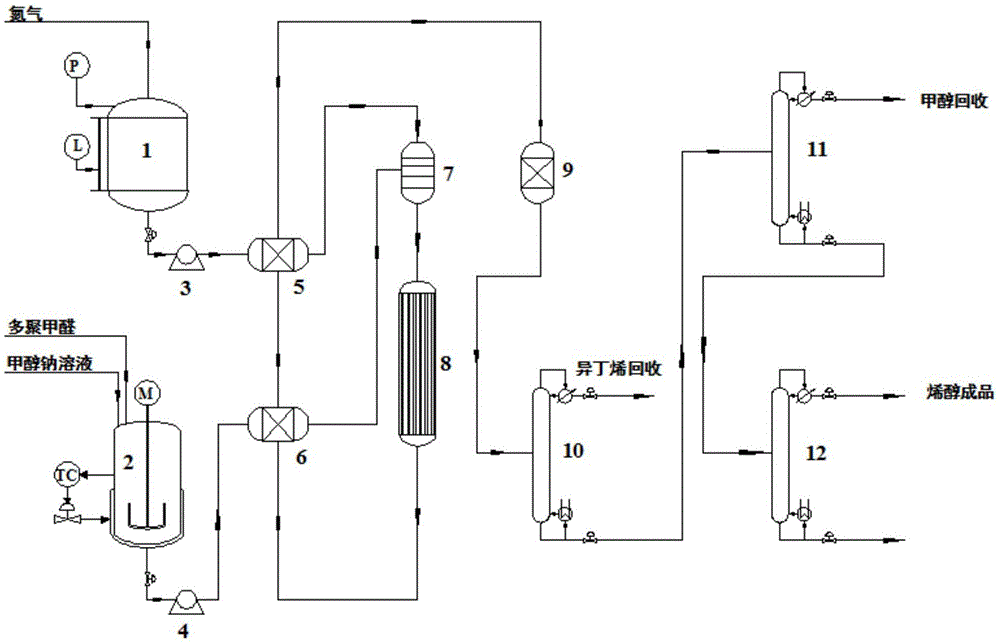Continuous 3-methyl-3-buten-1-ol production method
A technology of butene and methyl, applied in the field of organic chemical industry, can solve the problems of low heat and mass transfer efficiency, low production efficiency, and high reaction pressure, and achieve the advantages of avoiding formaldehyde residue, improving conversion rate, and reducing reaction temperature and reaction time. Effect
- Summary
- Abstract
- Description
- Claims
- Application Information
AI Technical Summary
Problems solved by technology
Method used
Image
Examples
Embodiment 1
[0032] use figure 1 The shown continuous reaction device carries out the following operation process. Add 100kg of paraformaldehyde and 450L of industrial sodium methoxide solution (3%) to the depolymerization kettle 2 in which paraformaldehyde is dissolved, heat to 40°C while stirring, continue stirring for 1h until the paraformaldehyde is completely dissolved, and then undergo heat exchange respectively 5 and 6, the materials are preheated, and the isobutene and formaldehyde hemiacetal are fed into the tubular reactor 8 with a molar ratio of 4:1, and the feeding space velocity is maintained for 1.2h -1 , maintain the reaction temperature at 170-180°C, the reaction pressure at 9-10MPa, and continue to react for 25 hours. Then the material enters the isobutene recovery tower 10, and the separated isobutene is cooled at -10--15°C and recovered to the isobutene storage tank. Light tower 11, methanol is separated for recycling, the bottom material flows into the product refining...
Embodiment 2
[0034] use figure 1 The shown continuous reaction device carries out the following operation process. Add 50 kg of paraformaldehyde and 220 L of industrial sodium methoxide solution (4%) to the depolymerization kettle 2 in which paraformaldehyde is dissolved, heat to 38° C. under stirring, continue stirring for 0.8 h until the paraformaldehyde is completely dissolved, and then respectively pass through Heaters 5 and 6 are used to preheat the materials to keep isobutylene and formaldehyde hemiacetal fed into the tubular reactor 8 at a molar ratio of 6:1, and the feed space velocity is maintained for 1h -1 , maintain the reaction temperature at 180-190°C, the reaction pressure at 8-9MPa, and continue the reaction for 14 hours. Then the material enters the isobutene recovery tower 10, and the separated isobutene is cooled at -10--15°C and recovered to the isobutene storage tank. Light tower 11, methanol is separated for recycling, the bottom material flows into the product refin...
Embodiment 3
[0036] use figure 1 The shown continuous reaction device carries out the following operation process. Add 80 kg of paraformaldehyde and 350 L of industrial sodium methoxide solution (2%) to the depolymerization kettle 2 in which paraformaldehyde is dissolved, heat to 42° C. under stirring, continue stirring for 1.2 h until the paraformaldehyde is completely dissolved, and then respectively pass through Heaters 5 and 6 are used to preheat the materials to keep isobutylene and formaldehyde hemiacetal fed into the tubular reactor 8 at a molar ratio of 4:1, and the feed space velocity is maintained for 1.5h -1 , maintain the reaction temperature at 160-170°C, the reaction pressure at 9-11MPa, and continue to react for 18 hours. Then the material enters the isobutene recovery tower 10, and the separated isobutene is recovered to the isobutene storage tank after low-temperature cooling at -10--15°C. Light tower 11, methanol is separated for recycling, the bottom material flows into...
PUM
 Login to View More
Login to View More Abstract
Description
Claims
Application Information
 Login to View More
Login to View More - R&D
- Intellectual Property
- Life Sciences
- Materials
- Tech Scout
- Unparalleled Data Quality
- Higher Quality Content
- 60% Fewer Hallucinations
Browse by: Latest US Patents, China's latest patents, Technical Efficacy Thesaurus, Application Domain, Technology Topic, Popular Technical Reports.
© 2025 PatSnap. All rights reserved.Legal|Privacy policy|Modern Slavery Act Transparency Statement|Sitemap|About US| Contact US: help@patsnap.com

